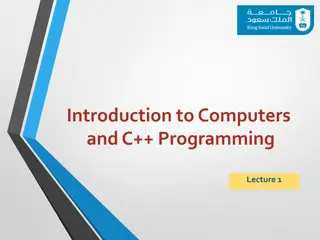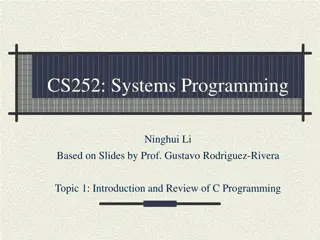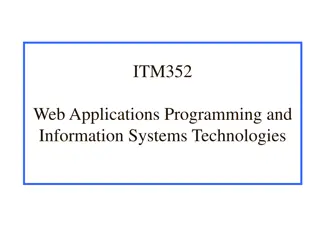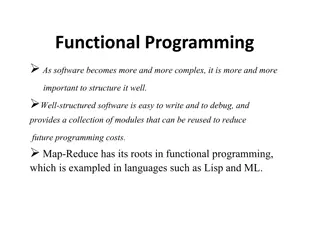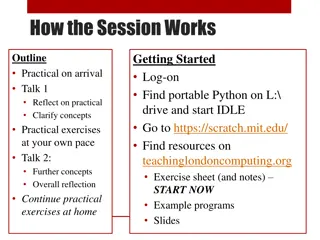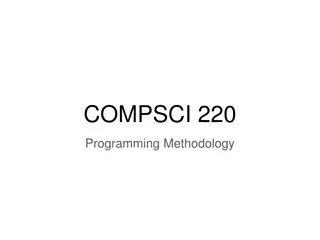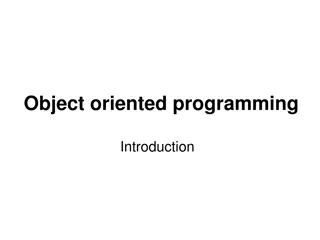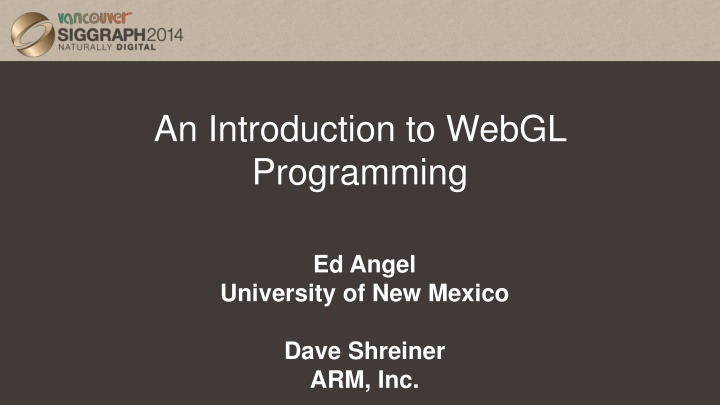
WebGL Programming Insights: Evolution, Concepts, and Applications
Explore the evolution of OpenGL pipeline to WebGL programming, understand OpenGL basics, shaders, and JavaScript implementation through examples like rotating cube and texture mapping. Learn about the significance of OpenGL and WebGL in creating high-quality color images for interactive applications. Gain insight into modern OpenGL architecture and the web environment for executing WebGL projects efficiently.
Uploaded on | 0 Views
Download Presentation

Please find below an Image/Link to download the presentation.
The content on the website is provided AS IS for your information and personal use only. It may not be sold, licensed, or shared on other websites without obtaining consent from the author. If you encounter any issues during the download, it is possible that the publisher has removed the file from their server.
You are allowed to download the files provided on this website for personal or commercial use, subject to the condition that they are used lawfully. All files are the property of their respective owners.
The content on the website is provided AS IS for your information and personal use only. It may not be sold, licensed, or shared on other websites without obtaining consent from the author.
E N D
Presentation Transcript
An Introduction to WebGL Programming Ed Angel University of New Mexico Dave Shreiner ARM, Inc.
Agenda Evolution of the OpenGL Pipeline Prototype Applications in WebGL OpenGL Shading Language (GLSL) Vertex Shaders Fragment Shaders Examples
Examples rotating cube with buttons cube with lighting texture mapped cube
What Is OpenGL? OpenGL is a computer graphics rendering application programming interface, or API (for short) With it, you can generate high-quality color images by rendering with geometric and image primitives It forms the basis of many interactive applications that include 3D graphics By using OpenGL, the graphics part of your application can be operating system independent window system independent
What Is WebGL? WebGL: JavaScript implementation of OpenGL ES 2.0 runs in all recent browsers (Chrome, Firefox, IE, Safari) operating system independent window system independent application can be located on a remote server rendering is done within browser using local hardware uses HTML5 canvas element integrates with standard Web packages and apps CSS jQuery
What do you need to know? Web environment and execution Modern OpenGL basics pipeline architecture shader based OpenGL OpenGL Shading Language (GLSL) JavaScript
In the Beginning OpenGL 1.0 was released on July 1st, 1994 Its pipeline was entirely fixed-function the only operations available were fixed by the implementation Vertex Vertex Data Transform and Lighting Primitive Setup and Rasterization Fragment Coloring and Texturing Blending Pixel Data Texture Store The pipeline evolved but remained based on fixed-function operation through OpenGL versions 1.1 through 2.0 (Sept. 2004)
Beginnings of The Programmable Pipeline OpenGL 2.0 (officially) added programmable shaders vertex shading augmented the fixed-function transform and lighting stage fragment shading augmented the fragment coloring stage However, the fixed-function pipeline was still available Vertex Vertex Data Transform and Lighting Primitive Setup and Rasterization Fragment Coloring and Texturing Blending Pixel Data Texture Store
An Evolutionary Change OpenGL 3.0 introduced the deprecation model the method used to remove features from OpenGL The pipeline remained the same until OpenGL 3.1 (released March 24th, 2009) Introduced a change in how OpenGL contexts are used Context Type Description Includes all features (including those marked deprecated) available in the current version of OpenGL Full Forward Includes all non-deprecated features (i.e., creates a context that
OpenGL ES and WebGL OpenGL ES 2.0 Designed for embedded and hand-held devices such as cell phones Based on OpenGL 3.1 Shader based WebGL JavaScript implementation of ES 2.0 Runs on most recent browsers
Simplified Pipeline Model Application Framebuffer GPU Data Flow Vertices Pixels Vertices Fragments Vertex Processing Fragment Processing Rasterizer Vertex Shader Fragment Shader
WebGL Programming in a Nutshell All WebGL programs must do the following: Set up canvas to render onto Generate data in application Create shader programs Create buffer objects and load data into them Connect data locations with shader variables Render
Application Framework WebGL applications need a place to render into HTML5 Canvas element We can put all code into a single HTML file We prefer to put setup in an HTML file and application in a separate JavaScript file HTML file includes shaders HTML file reads in utilities and application
A Really Simple Example Generate one red triangle Has all the elements of a more complex application vertex shader fragment shader HTML canvas www.cs.unm.edu/~angel/WebGL
triangle.html <!DOCTYPE html> <html> <head> <script id="vertex-shader" type="x-shader/x-vertex"> attribute vec4 vPosition; void main() { gl_Position = vPosition; } </script> <script id="fragment-shader" type="x-shader/x-fragment"> precision mediump float; void main() { gl_FragColor = vec4( 1.0, 0.0, 0.0, 1.0 ); }
triangle.html <script type="text/javascript" src="../Common/webgl-utils.js"></script> <script type="text/javascript" src="../Common/initShaders.js"></script> <script type="text/javascript" src="triangle.js"></script> </head> <body> <canvas id="gl-canvas" width="512" height="512"> Oops ... your browser doesn't support the HTML5 canvas element </canvas> </body> </html>
triangle.js var gl; var points; window.onload = function init() { var canvas = document.getElementById( "gl-canvas" ); gl = WebGLUtils.setupWebGL( canvas ); if ( !gl ) { alert( "WebGL isn't available" ); } var vertices = new Float32Array([-1, -1, 0, 1, 1, -1]); // Configure WebGL gl.viewport( 0, 0, canvas.width, canvas.height ); gl.clearColor( 1.0, 1.0, 1.0, 1.0 );
triangle.js // Load shaders and initialize attribute buffers var program = initShaders( gl, "vertex-shader", "fragment-shader" ); gl.useProgram( program ); // Load the data into the GPU var bufferId = gl.createBuffer(); gl.bindBuffer( gl.ARRAY_BUFFER, bufferId ); gl.bufferData( gl.ARRAY_BUFFER, vertices, gl.STATIC_DRAW );
triangle.js // Associate out shader variables with our data buffer var vPosition = gl.getAttribLocation( program, "vPosition" ); gl.vertexAttribPointer( vPosition, 2, gl.FLOAT, false, 0, 0 ); gl.enableVertexAttribArray( vPosition ); render(); }; function render() { gl.clear( gl.COLOR_BUFFER_BIT ); gl.drawArrays( gl.TRIANGLES, 0, 3 ); }
Representing Geometric Objects Geometric objects are represented using vertices A vertex is a collection of generic attributes positional coordinates colors texture coordinates any other data associated with that point in space Position stored in 4 dimensional homogeneous coordinates Vertex data must be stored in vertex buffer objects (VBOs)
OpenGL Geometric Primitives All primitives are specified by vertices GL_LINES GL_LINE_STRIP GL_LINE_LOOP GL_POINTS GL_TRIANGLES GL_TRIANGLE_FAN GL_TRIANGLE_STRIP
Our Second Program Render a cube with a different color for each face Our example demonstrates: simple object modeling building up 3D objects from geometric primitives building geometric primitives from vertices initializing vertex data organizing data for rendering interactivity animation
Initializing the Cubes Data We ll build each cube face from individual triangles Need to determine how much storage is required (6 faces)(2 triangles/face)(3 vertices/triangle) var numVertices = 36; To simplify communicating with GLSL, we ll use a package MV.js which contains a vec3object similar to GLSL svec3 type
Initializing the Cubes Data (contd) Before we can initialize our VBO, we need to stage the data Our cube has two attributes per vertex position color We create two arrays to hold the VBO data var points = []; var colors = [];
Cube Data Vertices of a unit cube centered at origin sides aligned with axes var vertices = [ vec4( -0.5, -0.5, 0.5, 1.0 ), vec4( -0.5, 0.5, 0.5, 1.0 ), vec4( 0.5, 0.5, 0.5, 1.0 ), vec4( 0.5, -0.5, 0.5, 1.0 ), vec4( -0.5, -0.5, -0.5, 1.0 ), vec4( -0.5, 0.5, -0.5, 1.0 ), vec4( 0.5, 0.5, -0.5, 1.0 ), vec4( 0.5, -0.5, -0.5, 1.0 ) ]; 6 7 1 2 4 7 3 0
Cube Data (contd) We ll also set up an array of RGBA colors We can use vec3 or vec4 or just JS array var vertexColors = [ [ 0.0, 0.0, 0.0, 1.0 ], // black [ 1.0, 0.0, 0.0, 1.0 ], // red [ 1.0, 1.0, 0.0, 1.0 ], // yellow [ 0.0, 1.0, 0.0, 1.0 ], // green [ 0.0, 0.0, 1.0, 1.0 ], // blue [ 1.0, 0.0, 1.0, 1.0 ], // magenta [ 0.0, 1.0, 1.0, 1.0 ], // cyan [ 1.0, 1.0, 1.0, 1.0 ] // white ];
Arrays in JS A JS array is an object with attributes and methods such as length, push() and pop() fundamentally different from C-style array cannot send directly to WebGL functions use flatten() function to extract data from JS array gl.bufferData( gl.ARRAY_BUFFER, flatten(colors), gl.STATIC_DRAW );
Generating a Cube Face from Vertices To simplify generating the geometry, we use a convenience function quad() create two triangles for each face and assigns colors to the vertices function quad(a, b, c, d) { var indices = [ a, b, c, a, c, d ]; for ( var i = 0; i < indices.length; ++i ) { points.push( vertices[indices[i]] ); // for vertex colors use //colors.push( vertexColors[indices[i]] ); // for solid colored faces use colors.push(vertexColors[a]); }
Generating the Cube from Faces Generate 12 triangles for the cube 36 vertices with 36 colors function colorCube() { quad( 1, 0, 3, 2 ); quad( 2, 3, 7, 6 ); quad( 3, 0, 4, 7 ); quad( 6, 5, 1, 2 ); quad( 4, 5, 6, 7 ); quad( 5, 4, 0, 1 ); } 6 7 1 2 4 7 3 0
Storing Vertex Attributes Vertex data must be stored in a Vertex Buffer Object (VBO) To set up a VBO we must create an empty by calling gl.createBuffer(); () bind a specific VBO for initialization by calling gl.bindBuffer( gl.ARRAY_BUFFER, vBuffer ); load data into VBO using (for our points) gl.bufferData( gl.ARRAY_BUFFER, flatten(points), gl.STATIC_DRAW );
Vertex Array Code Associate shader variables with vertex arrays var cBuffer = gl.createBuffer(); gl.bindBuffer( gl.ARRAY_BUFFER, cBuffer ); gl.bufferData( gl.ARRAY_BUFFER, flatten(colors), gl.STATIC_DRAW ); var vColor = gl.getAttribLocation( program, "vColor" ); gl.vertexAttribPointer( vColor, 4, gl.FLOAT, false, 0, 0 ); gl.enableVertexAttribArray( vColor ); var vBuffer = gl.createBuffer(); gl.bindBuffer( gl.ARRAY_BUFFER, vBuffer ); gl.bufferData( gl.ARRAY_BUFFER, flatten(points), gl.STATIC_DRAW ); var vPosition = gl.getAttribLocation( program, "vPosition" ); gl.vertexAttribPointer( vPosition, 3, gl.FLOAT, false, 0, 0 ); gl.enableVertexAttribArray( vPosition );
Drawing Geometric Primitives For contiguous groups of vertices, we can use the simple render function function render() { gl.clear( gl.COLOR_BUFFER_BIT | gl.DEPTH_BUFFER_BIT); gl.drawArrays( gl.TRIANGLES, 0, numVertices ); requestAnimFrame( render ); } gl.drawArrays initiates vertex shader requestAnimationFrame needed for redrawing if anything is changing Note we must clear both the frame buffer and the depth buffer Depth buffer used for hidden surface removal enable HSR by gl.enable(gl.GL_DEPTH) in init()
Vertex Shaders A shader that s executed for each vertex Each instantiation can generate one vertex Outputs are passed on to rasterizer where they are interpolated and available to fragment shaders Position output in clip coordinates There are lots of effects we can do in vertex shaders Changing coordinate systems Moving vertices Per vertex lighting: height fields
Fragment Shaders A shader that s executed for each potential pixel fragments still need to pass several tests before making it to the framebuffer There are lots of effects we can do in fragment shaders Per-fragment lighting Texture and bump Mapping Environment (Reflection) Maps
GLSL OpenGL Shading Language C like language with some C++ features 2-4 dimensional matrix and vector types Both vertex and fragment shaders are written in GLSL Each shader has a main()
GLSL Data Types Scalar types: float, int, bool Vector types: vec2, vec3, vec4 ivec2, ivec3, ivec4 bvec2, bvec3, bvec4 Matrix types: mat2, mat3, mat4 Texture sampling: sampler1D, sampler2D, sampler3D, samplerCube C++ Style Constructors vec3 a = vec3(1.0, 2.0, 3.0);
Operators Standard C/C++ arithmetic and logic operators Overloaded operators for matrix and vector operations mat4 m; vec4 a, b, c; b = a*m; c = m*a;
Components and Swizzling Access vector components using either: [ ] (C-style array indexing) xyzw, rgba or strq (named components) For example: vec3 v; v[1], v.y, v.g, v.t- all refer to the same element Component swizzling: vec3 a, b; a.xy = b.yx;
Qualifiers attribute vertex attributes from application varying copy vertex attributes and other variables from vertex shaders to fragment shaders values are interpolated by rasterizer varying vec2 texCoord; varying vec4 color; uniform shader-constant variable from application uniform float time; uniform vec4 rotation;
Functions Built in Arithmetic: sqrt, power, abs Trigonometric: sin, asin Graphical: length, reflect User defined
Built-in Variables gl_Position (required) output position from vertex shader gl_FragColor (required) output color from fragment shader gl_FragCoord input fragment position gl_FragDepth input depth value in fragment shader
Simple Vertex Shader for Cube Example attribute vec4 vPosition; attribute vec4 vColor; varying vec4 fColor; void main() { fColor = vColor; gl_Position = vPosition; }
Simple Fragment Shader for Cube Example precision mediump float; varying vec4 fColor; void main() { gl_FragColor = fColor; }
Getting Your Shaders into WebGL Shaders need to be compiled and linked to form an executable shader program WebGL provides the compiler and linker A WebGL program must contain vertex and fragment shaders Create Program gl.createProgram() Create Shader These steps need to be repeated for each type of shader in the shader program gl.createShader() Load Shader Source gl.shaderSource() Compile Shader gl.compileShader() Attach Shader to Program gl.attachShader() Link Program gl.linkProgram() Use gl.useProgram() Program
A Simpler Way We ve created a function for this course to make it easier to load your shaders available at course website initShaders(vFile, fFile ); initShaders takes two filenames vFile path to the vertex shader file fFile for the fragment shader file Fails if shaders don t compile, or program doesn t link
Associating Shader Variables and Data Need to associate a shader variable with an OpenGL data source vertex shader attributes app vertex attributes shader uniforms app provided uniform values OpenGL relates shader variables to indices for the app to set Two methods for determining variable/index association specify association before program linkage query association after program linkage
Determining Locations After Linking Assumes you already know the variables names loc = gl.getAttribLocation( program, name ); loc = gl.getUniformLocation( program, name );






